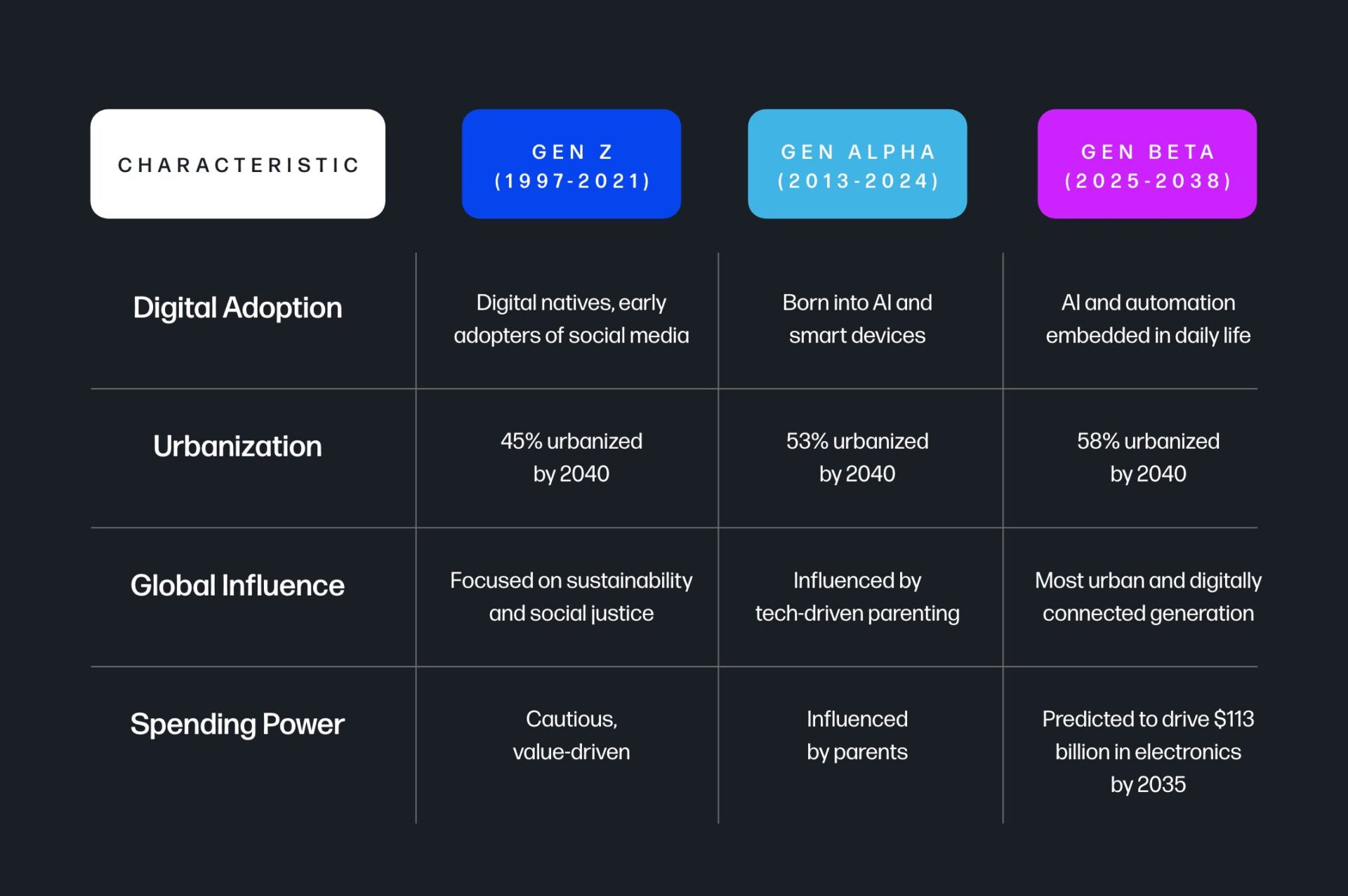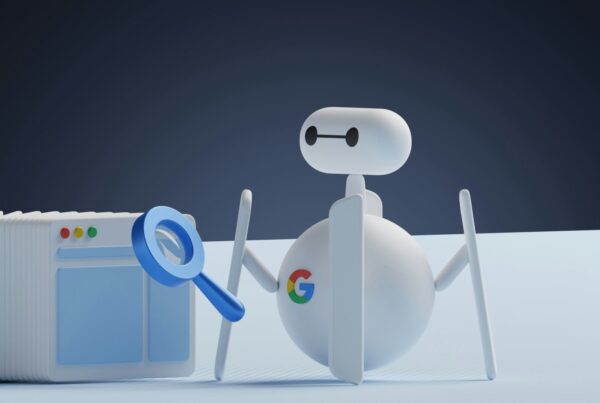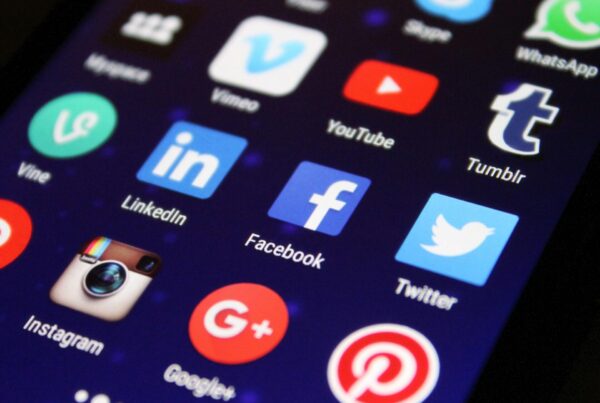The world of marketing is always changing, but few changes are as big as a new generation. Enter Generation Beta, born starting in January 2025 and going through 2039. Mostly the kids of Millennials and Gen Zers, Gen Beta will make up 18% of the global population by 2050. With an upbringing in urban environments and a life surrounded by AI and automation, this generation will redefine consumer behavior, spending habits, and brand loyalty. For marketers, understanding Gen Beta is not just about the future, it’s about being relevant in an increasingly complex digital landscape.
To understand what makes Gen Beta so cool, we need to look back at Gen Z and Gen Alpha, the generations they’ll follow. By comparing these two, we can see how the trends of today will evolve into the characteristics of Gen Beta.
Looking Back at Gen Z and Gen Alpha
Gen Z: The Authenticity Seekers
Born between 1997 and 2012, Gen Z is the first real digital native generation. They’ve never known a world without smartphones, social media, or instant access to information. Financially cautious, 64% of Gen Z prefer saving money over spending it, according to a report by Ernst & Young. They value authenticity above all else, gravitate toward brands that align with their personal values, such as sustainability and social justice.
When it comes to brand loyalty, Gen Z isn’t swayed by traditional advertising. Instead, they rely on peer reviews and influencer endorsements—44% of them have made a purchase based on an influencer’s recommendation, according to Morning Consult. For marketers, authenticity isn’t optional; it’s required.
Gen Alpha: The AI Natives
After Gen Z comes Gen Alpha, born between 2013 and 2024. They’re the first generation to grow up in a world where AI and smart devices are part of everyday life. Predictions suggest that 90% of Gen Alpha kids will use a smartphone by age 12. Their exposure to technology is unparalleled, making them highly adaptive and tech-savvy consumers.
Unlike Gen Z, who had to adjust to digital advancements during their teenage years, Gen Alpha’s digital literacy is innate. YouTube is their go-to platform, with 80% of kids 6-12 choosing it over traditional TV, according to Common Sense Media. As they grow up, their expectations for interactive and personalized digital experiences will only get higher.
Who is Gen Beta? A Demographic Snapshot
Generation Beta will include those born between 2025 and 2039. They’ll be the most urban and digitally connected generation ever, with a projected 58% of them living in cities by 2040, compared to 53% of Gen Alpha and 45% of Gen Z. This urban shift means a growing focus on convenience, smart city solutions, and fast access to services.
The Most Urban Generation Ever
By 2040, over half of Gen Beta will live in urban areas, a big jump from previous generations. Urban living means a huge demand for convenience-driven products and services—think one-hour deliveries, seamless mobile payments, and app-based solutions for everything from transportation to healthcare. For marketers, this means hyper-local advertising and convenience in brand messaging.
A More Globally Diverse Generation
Unlike their predecessors, only 46% of Gen Beta will be born in the Asia-Pacific region, a sharp decline from 61% of Gen X. Sub-Saharan Africa will have the most population growth, and one in three Gen Betas will be born on the continent. This demographic shift means brands will have to rethink their strategies and localize their marketing and messaging to capture this emerging market.
A Bridge Generation for Technology
If Gen Alpha is the AI-native generation, then Gen Beta will be the bridge generation for AI and automation. They will grow up in a world where AI-driven decision-making, personalized shopping experiences, and automated customer service are the norm. According to World Data Lab, Gen Beta is projected to spend $113 billion on consumer electronics by 2035, 2.4 times greater than Gen X’s projected spending. This spending pattern emphasizes the need for brands to invest in AI-driven marketing strategies now.
Shifting Economic Power: Spending Moves East
Nearly 40% of Gen Beta’s spending will occur in the Asia-Pacific region, with India and China accounting for a substantial share. This trend is particularly significant as fewer births in Asia will be offset by increasing purchasing power. By 2050, high-income countries such as the U.S. and those in Europe will contribute just 8% to the global Gen Beta population, yet will still account for 41% of overall spending.
This shift in spending power means that marketers must adopt a more global perspective, investing in localized content, international SEO, and cross-border eCommerce capabilities.
Key Differences Between Gen Z, Alpha, and Beta

Challenges Marketers Will Face with Gen Beta
Privacy Concerns: A Privacy-First World
Gen Beta will grow up in a world where data breaches and privacy scandals are common news. With GDPR and the California Consumer Privacy Act (CCPA) becoming the norm, younger generations are already more aware of their digital footprints than ever before. According to a Cisco survey, 86% of consumers care about data privacy and want more control over how their information is used. For Gen Beta, this concern will only get worse.
Brands will need to:
- Design for privacy: Privacy built into every stage of product development.
- Be transparent: Clear privacy policies and easy-to-read terms of service will build trust.
- Empower users: Customizable privacy settings and data control will be the norm for a generation raised on digital autonomy.
If you don’t address these issues, you will lose trust and brand loyalty, making privacy compliance not just a legal requirement but a marketing strategy.
Shorter Attention Spans: Instant Engagement
As digital natives, Gen Beta will have even shorter attention spans than Gen Z and Gen Alpha. Microsoft research suggests the average human attention span has dropped to 8 seconds, shorter than a goldfish. With the rise of TikTok, YouTube Shorts, and Instagram Reels, this will only get worse.
To capture their attention, brands will need to:
- Create snackable content: Short-form videos, interactive ads, and infographics can convey messages quickly.
- Optimize for speed: Fast-loading pages and seamless mobile experiences will be non-negotiable.
- Add gamification: Interactive elements, rewards, and challenges will make marketing content more engaging and memorable.
You’ll need to hook Gen Beta in with short, shiny content that delivers value fast.
Higher Expectations for Personalization: From Generic to Hyper-Personalized
Gen Beta will grow up in a world where AI and machine learning are part of everyday life. So they’ll expect highly personalized experiences in every interaction—whether shopping online, streaming content, or engaging with brands on social media. According to Epsilon, 80% of consumers are more likely to make a purchase when brands offer personalized experiences.
Personalization strategies:
- AI-driven product recommendations: Using AI to suggest products based on browsing history, preferences, and even mood.
- Dynamic content: Personalized emails, websites, and ads that change based on user behavior and preferences.
- Predictive analytics: Using machine learning to forecast consumer behavior and deliver personalized offers at the right time.
However, the challenge will be in balancing personalization with privacy—overly invasive will backfire, so transparent data usage is key.
Ethical Expectations: Align with Values
Growing up in a world facing climate challenges and economic disparities, Gen Beta will likely focus more on sustainability and ethical consumption, trends already visible in Gen Z and Alpha. According to a study by Nielsen, 73% of Millennials are willing to spend more on sustainable brands, a sentiment that will only get stronger with Gen Beta.
Key areas:
- Sustainable sourcing: Highlighting eco-friendly materials and ethical production processes.
- Social responsibility: Supporting social justice initiatives and transparently communicating those efforts.
- Circular economy models: Emphasizing product recycling, upcycling, and buy-back programs.
Brands that align with those values authentically will not only attract Gen Beta but will also retain loyalty across generations.
How Marketers Can Get Ready for Gen Beta
Invest in AI and Automation: Scaling Personalization
As AI becomes part of daily life, investing in AI-driven marketing tools is no longer optional. Predictive analytics, chatbots, and recommendation engines can help brands deliver personalized experiences at scale. A report by McKinsey estimates AI could unlock $1.4 trillion to $2.6 trillion in marketing and sales value annually.
Actionable Steps:
- Use machine learning to forecast trends and personalize content.
- Automate customer service with AI chatbots.
- Improve user experience with AI-driven A/B testing and optimization.
Prepare for Global Diversity: Think Local, Act Global
With population growth expected in regions like Sub-Saharan Africa and Asia, brands must adopt a globally diverse marketing strategy. This means localizing content for different languages, cultural contexts, and social norms.
Strategies:
- Localized SEO: Optimize content for local search engines and languages.
- Culturally relevant content: Create ads and narratives that resonate with regional values.
- Partnerships: Collaborate with local influencers and businesses to build credibility.
Emphasize Sustainability: Build Purpose-Driven Brands
Gen Beta will inherit a world with climate challenges and resource constraints. Brands that champion sustainability will not only appeal to Gen Beta but also stand out in a crowded marketplace.
Ways to Stand Out:
- Carbon-neutral pledges: Communicate efforts to offset carbon emissions.
- Eco-friendly packaging: Use recyclable or biodegradable materials.
- Transparency reports: Publishing data on sustainability efforts and progress regularly.
Omnichannel Experiences: Seamless Across All Platforms
Growing up in a hyper-connected world, Gen Beta will expect brands to deliver a seamless experience across all touchpoints, online, offline, or on smart devices.
Tactics:
- Unified customer profiles: Centralize data for consistent experiences.
- Click-and-collect options: Integrate online and offline shopping.
- AR/VR experiences: Using augmented and virtual reality for product demos.
Takeaways for Marketers
- Start Now: Although Gen Beta is still in its infancy, brands that build loyalty with Millennial and Gen Z parents today will have an edge.
- Use AI: Predictive analytics, AI chatbots, and personalized experiences will be key.
- Go Global: As spending power shifts, global campaigns will become more important.
- Values Matter: Sustainability and ethical practices will resonate strongly with this generation.
Get Ready with Brandastic
The rise of Gen Beta is a challenge and an opportunity for marketers. As the most urban, globally diverse, and tech-savvy generation yet, they will demand more from brands in terms of personalization, transparency, and ethics. Those that don’t adapt will become obsolete.
At Brandastic, we expertly help brands not just survive but thrive in times of change. Work with Brandastic to future-proof your marketing strategy and be ready for the fast-paced digital world. From AI-powered personalization to data analytics and sustainable marketing strategies, we’ll help you connect with the consumers of tomorrow.
And who knows, by the time we figure out marketing to Gen Beta, we might need to start preparing for Gen Gamma. Because one thing is for sure, the future doesn’t wait.
Contact us today and let’s build something for Gen Beta today and tomorrow!













